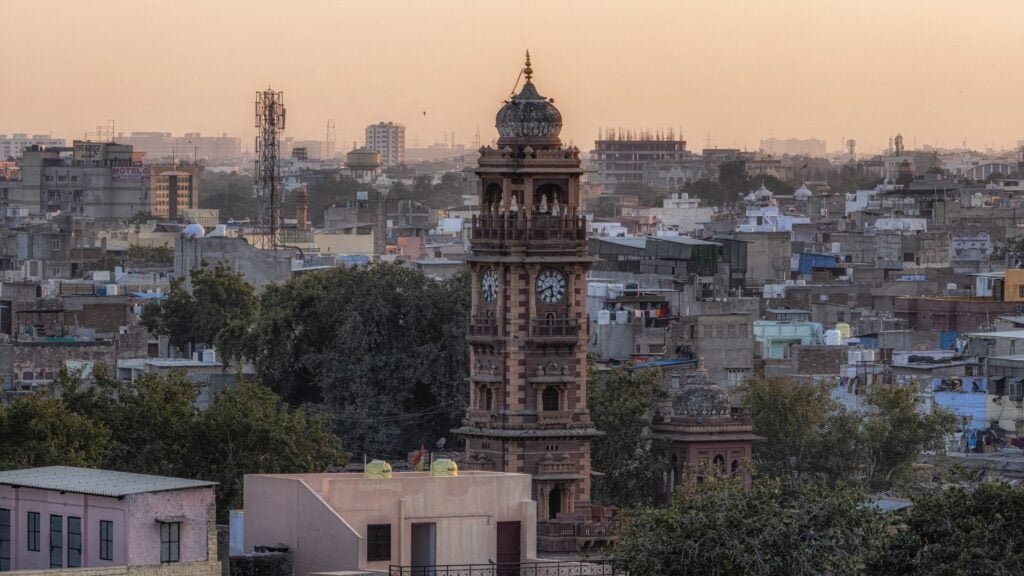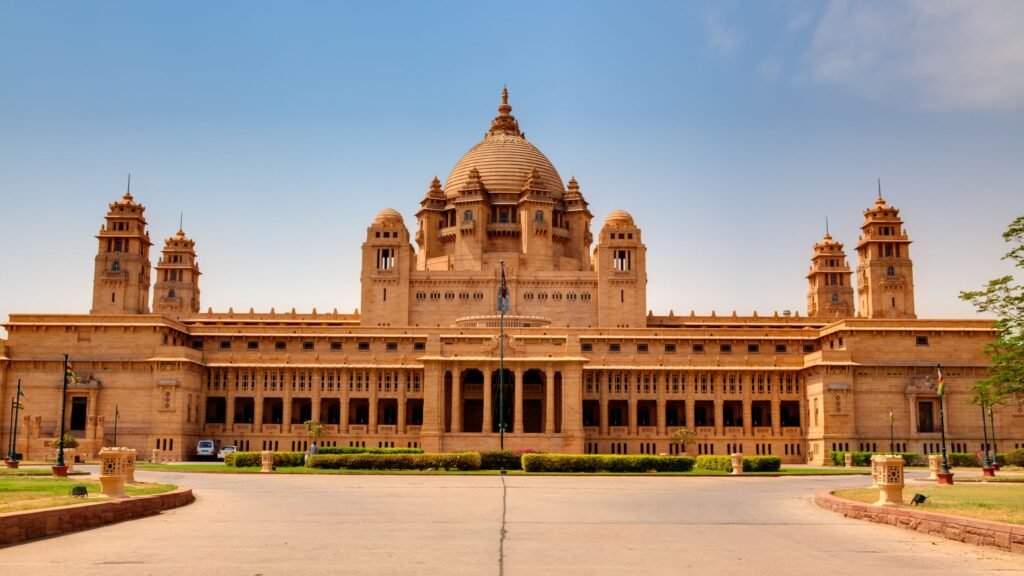Read this Jodhpur travel blog to know the places to visit, things to do, food to eat, and shopping tips.

“Wandering through the bustling streets of Jodhpur feels like a magnificent leap into the past”
Founded by the Rajput ruler Rao Jodha Rathore in 1459, Jodhpur (City of Jodha) was the capital of the Kingdom of Marwar, whereas now it is the second largest and second most important metropolis in Rajasthan.
Ambling around the city of Jodhpur is a fantastic time travel back into the bygones – the breathtaking backdrop of the gigantic browny hill fort of Mehrangarh surrounded by tiny closely packed neighborhoods of the Old City whose flat houses are washed with a tint of blue, is the picture-perfect capture that has defined Jodhpur in one frame since aeons. The spellbinding frame can speak more than a thousand words about the erstwhile glories of the kingdom for which it came to be the unyielding seat of power.
One of the most culturally intact cities of Rajasthan, people visiting Jodhpur are usually left enthralled with the ‘ghoomar’ dances, sufi music, tribal articles, folklore, and Marwari cuisine.
The merchants who come from this region are called the Marwaris who are known for their business tactics and flourished in their trade so much so to have become popular nationwide and nowadays even beyond borders.
Although centrally located in the state of Rajasthan, owing to its tactile location on the Thar desert, Jodhpur acts as a key base for the Indian Army; besides it proudly holds one of Asia’s largest Air Command.
Extensively well connected by road to all other major cities, Jodhpur as of today is increasingly gaining recognition for its strong foothold in the education and research sectors as evident from the large number of nationally recognized institutions that are present there. However, the tourism market lays emphasis only around the historical points of interest.
As it is with most places in Rajasthan, the ideal time to explore Jodhpur is usually during the winter months with tolerable temperatures, and advisable to avoid harsh summers.
Read on to know what’s interesting in the Blue City of India!
1. Mehrangarh Fort

Literally means “Fort of the Sun” – an expansive and impregnable citadel sturdily perched 400 ft above, still merging with the rock below on which it stands, was constructed by Rao Jodha, king of the Rathore clan, to effectively shift his capital from Mandore to Jodhpur. Composed of numerous courtyards, towering gates, plush rooms, and royal furniture, the palace-fortress is an architectural marvel which is spellbinding at every turn, both from outside and inside.
The colossal structure which is about 500 m wide and 120 ft high is still very much under the control of the living members of the Royal Family of Jodhpur. The panoramic bird view of the ‘blue city’ below, from the highest terrace on the fort is a spectacular feast for the eyes!
Mehrangarh is special for its expensive, lustrous, and characteristically designed rooms & galleries, which have been given distinct names such as Phool Mahal, Sheesh Mahal, Moti Mahal, Painting Gallery, Palanquin Gallery, Arms Gallery, and so on; with outstanding features including colorful glass windows, beautiful woodwork plated with gold, exquisite mirror work, delicate filigree work, impressive latticework and exclusive miniature paintings of deities.
According to author Rudyard Kipling, Mehrangarh is “the work of giants”. The giant fort has earned the name of being one of the well-maintained forts as well as the only fort in India to operate an elevator.
Initially, the old city of Jodhpur was bounded by the Fort and its walled gates; whereas now the new city has developed much further beyond these limits.
ALSO READ: Top Tourist Sport in Pink City Travellers Need to Know
2. Blue city Heritage walk

There could be a number of compelling reasons for which the ‘indigo-blue’ color became Jodhpur’s favorite shade in the color palette – to denote the color of the Brahmins, to feel cooler in the hot and sunny town, to repel termites, to show devotion towards Lord Shiva etc.
But what are of interest to travelers are – ample photo opportunities in the azure background of small houses with pretty doors, classical walking tours in the cobweb of ‘blue’ alleys, genuine interactions with the locals, and a sneak-peak into the 500-years old civilization in this part of the town adjoining the fort, that has preserved its ‘blue’ heritage since many a century.
Alarmingly, this legacy of pockets of blue houses, often prided upon as India’s very own Morocco, is under threat of extinction for the present generation of people are more inclined towards experimenting with colors than just clinging to the ‘blues’. Hence the ‘blue’scape of the city is undergoing a gradual change wherein a number of houses are seen to be getting rid of the age-old custom of painting ‘blue’ for a long-due change of color.
3. Toorji Ka Jhalra

An 18th-century Step Well Square made with red sandstone that goes to a depth of about 200 feet below, was commissioned by Maharani Toorji, the queen of Jodhpur. Although an underrated location, the craftsmanship with respect to detailing and symmetry of steps on display over here is a sight to behold. In recent times, it has managed to garner more attention because of a prominent ‘Step Well Café’ nearby that offers a full blown view of the step-well from its 3-floored levels.
4. Jaswant Thada

A large cenotaph built between 1899 – 1906, by Maharaja Sardar Singh for his father Maharaja Jaswant Singh II, is particularly noted for being made with thin sheets of white marble that emit a warm glow during sunlight. For this reason, it is also described as the ‘Taj Mahal of Marwar’. The memorial houses exhibits of portraits of many Jodhpur rulers. These days the serene venue is used for concerts during music festivals like the Rajasthan International Folk Festival; moreover the gorgeous Mehrangarh fort is quite closely visible from here.
5. Ghanta Ghar

Ghanta Ghar or the Clock Tower, was supposedly the only means to know ‘time’ in the earlier days. It was built on the instruction of Maharaja Sardar Singh, the same ruler who had envisioned Jaswant Thada. This key landmark in the Old City, which is almost always crowded for the famed Sardar Market adjacent to it, is one of the conventional shopping areas.
6. Umaid Bhawan Palace

One of the largest royal residences in the world, Umaid Bhavan is a modern palace that was built for over 15 years and whose construction was completed in 1943. Spread over 26 acres in the midst of a sprawling lawn, the palacial building with more than 340 rooms and several halls, is a lavish amalgamation of Indian and European styles, made with yellow sandstone, makrana marble and Burmese teakwood.
The current owner and descendent of the royal family, Maharaj Gaj Singh II, has retained one part of the palace for his personal use while splitting the other into a luxury hotel (run by Taj Group) and a museum which is open to the public.
Culinary Journey in Jodhpur

No doubt Jodhpur seamlessly proves to be a soul-stirring destination for its rich cultural tapestry, but it is also the place that always tops the charts for serving bonafide and best-in-taste Rajasthani delicacies; much to the joy of every gastronome’s delight, who unquestioningly set forth on a food-pilgrimage whenever they set foot in this olden city.
In particular, the sweet-n-snack mart named ‘Jodhpur Sweets’ is famously found in many cities across India.
Presented here is a spread of some wonderful Jodhpuri fare to gratify your taste buds:
- Dal Bati Churma
- Shahi Samosa
- Makhaniya lassi
- Motu jalebi
- Pyaas ki kachori
- Mawa kachori
- Malai roti
- Gulab jamoon sabzi
- Gulab jamoon Halwa
- Ghevar
- Mirchi Bada
- Sev Tamatar
- Ker Sangri
- Gatte Sabzi
- Moong dal halwa
- Bajra roti
Shopping in Jodhpur

A shopping spree in the city is always a must for its remarkable things galore like spices (especially red chillis), ‘bandhini’ fabrics, ‘leheriya’ saris, ‘mojaris’ (shoes), antiques, traditional metal work handicrafts, silver jewelry, marble statues, puppet dolls, leather bags, block-printed linen and reversible quilted jackets.
Some of the best-loved markets for street shopping are Tripoli Bazaar, Clock Tower Market, Umaid Bhavan Palace Market, Mochi Bazaar, Nai Sarak, and Sarafa Bazaar.
